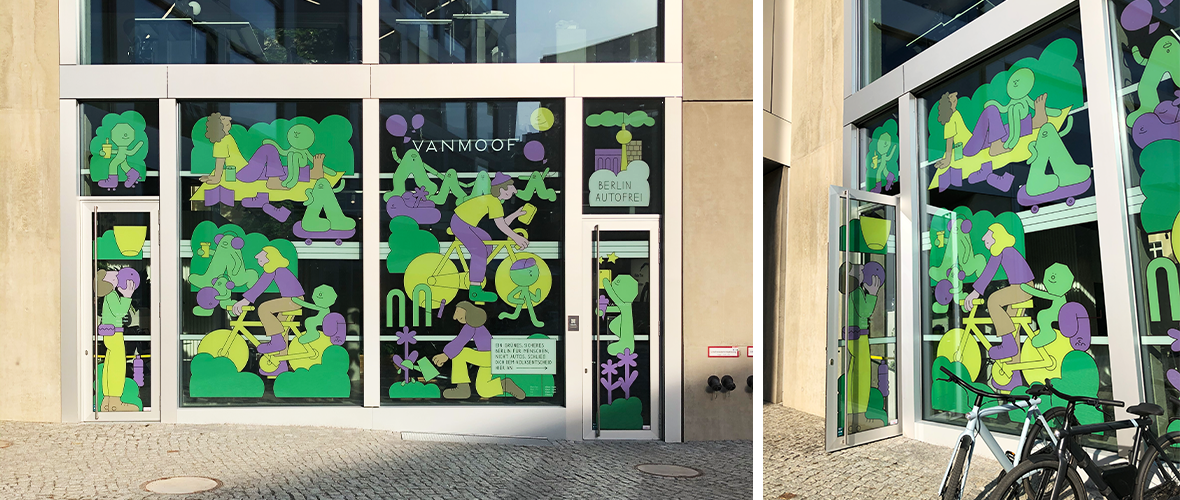
Start Making Space for People, Not Cars
1084 days ago
3 minutes
Source: VanMoof – In late May this year, VanMoof supported the Berlin Autofrei initiative which campaigns to transform Berlin’s streets within the S-Bahn-Ring into car-reduced spaces. To inspire their Berlin-based riders to sign the petition, they teamed up with artist Martina Paukova to illustrate a vibrantly colorful imagining of Berlin as a biketopia on our Brand Store windows. VanMoof spread the word and hundreds of VanMoof riders signed the petition. While Berlin Autofrei is busy counting up the first round of the 195,000 total signatures needed to force a referendum, they are taking the next step to help bring their ideas that reclaim Berlin’s space for people, not cars, to life.
VanMoof partnered with Berlin-based urban planner and sustainability specialist Tom Meiser, who plays a key role in the Berlin Autofrei initiative, to imagine tangible mobility solutions for the inner city of Berlin. Together with Tom, VanMoof has transformed five key traffic points into car-reduced, safe, and community-centric spaces to cater to the already shifting behavior patterns in Berlin and paint a vivid picture of the endless possibilities for the city center.
So, how do we encourage more people to bike? At VanMoof, their believe is that the solution lies in creating the best riding experience possible in cities across the world. But to achieve a truly long-lasting urban mobility revolution, legislators must provide city-dwellers with safe and crucial infrastructure. Based on their own data collected in collaboration with YouGov shows that cyclists in Berlin don’t feel safe riding in their city. While the number of cyclists on Berlin’s streets increased by 22% over the pandemic, the number of cycling casualties increased nearly threefold. The data speaks for itself. A lack of safe spaces and necessary infrastructure for riders is dangerous and in need of urgent addressing.
The Torstraße 42, home to VanMoof’s Brand Store, is just one area of Berlin that could benefit from a radical redesign. It’s currently a loud, congested six-lane road that’s the site of multiple accidents involving cyclists due to the absence of cycling infrastructure. Not tempted to ride down the Torstraße? Tom’s render splits up the road with a middle lane exclusively for public transport and taxis, and a segregated red bike lane to protect cyclists and minimise traffic conflicts. A green line for trees, flower beds, bike racks, and power plugs provides the necessary space and infrastructure for riders and pedestrians alike. Public life here becomes central, rather than sidelined in favor of cars. Phew. That’s better.

The Rosenthaler Platz is a five-road intersection with no cycling infrastructure in place – one of the most dangerous roads for cyclists. Tom’s solution – which envisages a color coded bike roundabout to segregate it from the road and protected pedestrian crossings – embraces the potential for a safer, more inclusive and diverse public space. Picture a pedestrianized market square in its center, where you could sit under the shade of a tree while sipping your morning coffee. It’s too good an opportunity to miss.

Find the complete article here.
Annick Roetynck
Annick is the Manager of LEVA-EU, with decades of experience in two-wheeled and light electric mobility.
Campaign success
Lorem ipsum dolor sit amet, consectetur adipisicing elit, sed do eiusmod tempor incididunt ut labore et dolore magna aliqua.
Member profile
Lorem ipsum dolor sit amet, consectetur adipisicing elit, sed do eiusmod tempor incididunt ut labore et dolore magna aliqua.